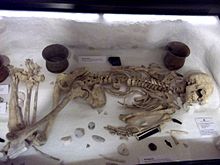Amesbury Archer
In May 2002 , a stool grave from the end Neolithic bell - cup culture was discovered in Amesbury , Great Britain . Excavators came across this grave with a rich set of grave goods while building a school . Amesbury is about 5 km from Stonehenge .
Find history
During a routine excavation on the site of a planned new school building, a small cemetery from Roman times was discovered by chance in May 2002. At one point, however, two other graves were discovered, the grave goods of which indicated a burial that was about 2500 years older.
Age and Skeleton
According to radiocarbon dating, the burial comes from around 2380 to 2290 BC and thus from the era in which Stonehenge was built. The man, who was around 35 to 45 years old when he died, came from the Alpine region (Switzerland, Austria or southern Germany), as analyzes of his tooth enamel have shown. A further examination of the skeleton revealed that the man was unable to walk and had a serious injury to his left knee: the knee was shattered, the kneecap was missing, and the bone was inflamed. He also had a painful jaw abscess .
Grave goods
The body was buried with an unusually large number of rich grave goods . So far no Bronze Age grave with so many grave goods (more than a hundred) has been discovered. That is ten times as many as were usually found in such graves. Therefore, the deceased was initially referred to in the English media as the "King of Stonehenge".
The grave goods were u. a. around several (16) arrowheads and two stone arm protection plates . Because of these additions he was called "Amesbury Archer" ( archer of Amesbury).
Copper knives were also included with the deceased . Of these high-quality, forged knives, which were very rare at the time, three were included with the body. The copper knives come from Spain and France.
In addition, there were a pair of gold earrings and gold hair clips in the grave. Gold was very rare and valuable back then. These trinkets are the oldest gold items found in Britain to date. Food was given to the deceased in richly decorated clay jugs.
Its cultural classification was based on the five bell beakers that were included .
Trade network
From the origin of the man and his grave goods, the archaeologists conclude that there is a wide-ranging trade network that already existed in the early Bronze Age. In addition, it can be assumed that manual skills such as metalworking were brought to Great Britain from Central Europe . According to archaeologists, the metals were imported.
Another grave
A nearby second grave contains the remains of a 20 to 25 year old man. Bone analyzes indicate a relationship between the two, which was also attached to the ankle bones of the dead, because both showed a fused scaphoid and heel bone . The younger man appears to have grown up in the Stonehenge area .
See also
literature
- Ulrich Graser: The Archer of Amersbury. A Swiss person who brings culture. in: G / Geschichte , issue 2/2014, p. 56f .; Bayard Media GmbH & Co. KG, Augsburg
- Almut Bick: The Stone Age. Extended new edition, 2012. Konrad Theiss Verlag, Darmstadt. ISBN 978-3-8062-2589-1
Web links
Individual evidence
- ↑ http://www.bbc.co.uk/history/ancient/archaeology/king_stonehenge_01.shtml
- ↑ Wessex Archeology The Amesbury Archer: Background ( Memento of the original from August 15, 2016 in the Internet Archive ) Info: The archive link was inserted automatically and has not yet been checked. Please check the original and archive link according to the instructions and then remove this notice.
